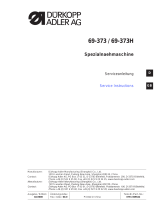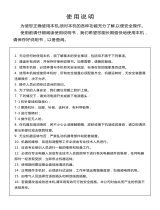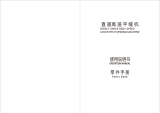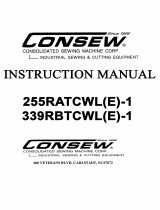Page is loading ...

887
Service Instructions

All rights reserved.
Property of Dürkopp Adler AG and copyrighted. Reproduction or publication of the content in any manner, even
in extracts, without prior written permission of Dürkopp Adler AG, is prohibited.
Copyright © Dürkopp
Adler AG - 2015

Introduction
This service booklet contains the instructions for setting the sewing machine
head mechanisms.
The directions for putting the machine into operation and for setting the
positioning drive are contained in another publication.
The service booklet is common for all subclasses of the machine and
contains also the instructions for setting optional accessories of the machine,
if this is necessary owing to their complexity. Provided the machine supplied
does not contain some elements, then the respective chapters may be
ignored.
The succession of the setting operations is expressed here by sequencing
the paragraphs of this booklet. When setting, check up, if the setting
operations related to this setting have already been performed.

General safety instructions
The non-observance of the following safety instructions can cause
bodily injuries or damages to the machine.
1. The machine must only be commissioned in full knowledge of the
instruction book and operated by persons with appropriate training.
2. Before putting into service also read the safety rules and
instructions of the motor supplier.
3. The machine must be used only for the purpose intended. Use of
the machine without the safety devices is not permitted. Observe all
the relevant safety regulations.
4. When gauge parts are exchanged (e.g. needle, presser foot, needle
plate, feed dog and bobbin) when threading, when the workplace is
left, and during service work, the machine must be disconnected
from the mains by switching off the master switch or disconnecting
the mains plug.
5. Daily servicing work must be carried out only by appropriately
trained persons.
6. Repairs, conversion and special maintenance work must only be
carried out by technicians or persons with appropriate training.
7. For service or repair work on pneumatic systems, disconnect the
machine from the compressed air supply system (max. 7-10 bar).
Before disconnecting, reduce the pressure of the maintenance unit.
Exceptions to this are only adjustments and functions checks made
by appropriately trained technicians.
8. Work on the electrical equipment must be carried out only by
electricians or appropriately trained persons.
9. Work on parts and systems under electric current is not permitted,
except as specified in regulations DIN VDE 0105.
10. Conversion or changes to the machine must be authorized by us
and made only in adherence to all safety regulations.
11. For repairs, only replacement parts approved by us must be used.
12. Commissioning of the sewing head is prohibited until such time as
the entire sewing unit is found to comply with EC directives.
13. The line cord should be equipped with a country-specific mains
plug. This work must be carried out by appropriately trained
technicians (see paragraph 8).
It is absolutely necessary to respect the safety
instructions marked by these signs.
Danger of bodily injuries !
Please note also the general safety instructions.

Index Page
Service Instructions for the Class 887
(Edition 09.2015)
1 General
1.1 Setting gauges ................................................ 5
1.2 Adjusting the handwheel .......................................... 6
1.2.1 Sewingmachinewithminimotor...................................... 6
1.2.2 Sewingmachinewithdirectdrive..................................... 7
2 Bottom feed
2.1 Basic setting for stitch adjustment and stitch length limit ....................... 8
2.2 Stitchuniformityforforwardsandreversestitching.......................... 9
2.3 Adjustingoffeedshaftpositionandclutchleverposition ...................... 10
2.4 Position of the eccentric tappet for the feed movement ........................ 11
2.5 Switchingoverthefeedclutch ...................................... 12
2.6 Position of the eccentric tappet for the switch over of the feed clutch ............... 13
2.7 Checkingtheswitchoverofthefeedclutch .............................. 14
2.8 Adjusting the reduced stitch length .................................... 15
2.9 Throatplate.................................................. 16
2.10 Slide wheel feeder .............................................. 17
2.10.1 Adjusting the wheel feeder height for single needle sewing machines ............... 17
2.10.2 Adjusting the wheel feeder height for double needle sewing machines
and sewing machines with edge trimmer ................................ 18
3 Top feed
3.1 Position of the needle holder with single needle sewing machines ................. 19
3.2 Needle feed .................................................. 20
3.3 Rollerfoot................................................... 22
3.4 Rollerfootlifting............................................... 23
3.5 Fabric holder for double needle sewing machines ........................... 24
4 Adjusting the needle bar and the hook
4.1 Needle bar height, play of needle to hook tip, loop stroke ...................... 25
4.2 Hook tip guard ................................................ 26
4.3 Bobbin housing release........................................... 27
4.4 Hooklubrication............................................... 28
5 Thread setting
5.1 Thread regulator, check spring, bolt for the thread lever mechanism................ 29
5.2 Bobbin winder................................................. 30
6 Thread cutter
6.1 General .................................................... 31
6.2 Position of the thread-pulling knife, position of the counter knife .................. 31
6.3 Starting position for the thread pulling knife............................... 32
6.4 Controlcam.................................................. 33

Index Page
6.5 Bobbin thread clamp............................................. 34
6.6 Positionofthethroatplateinsert..................................... 35
7 Sewn material edge trimmer control
7.1 Switching on/off edge trimmer ....................................... 36
7.2 Upper knife height adjustment ....................................... 37
7.3 Heightadjustmentofcuttingknife..................................... 38
7.4 Settingofside(lateral)positionofknife................................. 40
7.5 Setting of upper knife angle with regard to bottom cutting edge................... 41
7.6 Materialguideadjustment......................................... 42
7.7 Replacingthelowerknife.......................................... 43
7.8 Sharpening the upper knife......................................... 44
8 Electronic control and sew ing machine drive - positioning motor............... 45
8.1 Terminals to PCB connections - electromagnetic variant ....................... 46
8.2 Terminals to PCB connections - pneumatic variant .......................... 47

5
EN
1 General
These service instructions describe the adjustments that can be made
to the class 887 special sewing machine.
CAUTION!
The operations described in these service instructions may only be
carried out by qualified staff or other appropriately trained persons!
Caution: Risk of injury!
Turn the main switch off for repair, conversion and maintenance work
and separate the machine from the pneumatic supply line.
Any adjustment work and functional testing with the machine running
should be conducted only under observance of all safety measures
and with the greatest possible caution.
These service instructions describe the adjustment of the sewing
machine in a logical order. Please observe that various setting
positions are dependent on each other. Thus it is essential that the
settings be conducted while keeping to the order described.
For all adjustments of parts involved in the stitch formation, a new
undamaged needle must be inserted.
This text does not specifically mention any machine covers or panels
which must be removed or re-mounted in order to conduct inspections
or adjustments.
Note
Some shafts on the special 887 machine are provided with flat
eccentric surfaces. This significantly simplifies machine adjustments.
For all adjustments on flat surfaces, the first screw screwed in the
direction of the eccentric surface.
1.1 Setting gauges
The retention pin required for adjusting the machine in included with all
units. It is located with the machine accessories and can be attached
so that it is easily accessible below the oil tray.

1.2 Adjusting the handwheel
Rule:
The handwheel (4) is labelled with degree numbers.
Certain adjustments are made with these marked handwheel positions.
–
Turn the handwheel until the degree value specified in the
instructions is aligned with the pointer (3).
–
Proceed with the adjustment described.
When the needle bar is at top dead centre, the pointer (3) should be
aligned with “0” degrees.
1.2.1 Sewing machines with minimotor
–
Loosen the handwheel screws witha3mmAllenkey(1).
–
Position the needle bar in the upper dead centre position. Use the
retention pin (3 mm diameter) to peg the position (2).
–
Turn the handwheel so that the pointer (3) points to 0 degrees on
the rotary scale.
–
Tighten the first screw with the Allen key (1). Turn the handwheel
to 50° and tighten the second screw with the Allen key (1).
6
1
2
3
4

1.2.2 Sewing machine with direct drive
–
Unscrew three fixing screws on the hand wheel (5) and remove it.
–
Put the needle in the upper dead point and insert the setting pin
(2), which is a part of the sewing machine accessories and which is
fixed on the oil tray bottom side, into the crank head.
–
Loosen two setting screws of the hand wheel flange (4) with the
Allenkey3mm(1).
–
Turn the hand wheel flange with the hollow (6) against the sign (3).
–
Tighten both setting screws with the key (1) and fix the hand wheel
on again.
7
EN
24
1
36
5

2 Bottom feed
2.1 Basic setting for stitch adjustment and stitch length limit
Rule:
1. When setting the stitch length at “0”, the stitch regulator gear should
have as little play (clearance) as possible when you press down on
the bartacking lever.
2. The maximum stitch length limit depends on the material to be sewn
and the sewing equipment being used (see operating instructions).
–
Loosen screw (1) and take off the settings dial (2).
–
Turn the screw (3) as far as needed to the right using a 10 mm
open-ended wrench. Verify that the stitch regulator gear is without
motion by pressing down on the bartacking lever. This fulfils rule 1.
–
Set the scaling ring (4) with stitch length “0”toalignwiththe
circular mark (5).
–
Limit the stitch length according to rule 2. For this, screw the
retention pin (6) into the proper hole. The holes are marked with
numbers which indicate the maximum stitch length.
–
If a maximum stitch length of 7 mm is required, unscrew the
screw (6) for 2.5 mm. Another end stop is available for this length.
–
Put the settings dial (2) back on and tighten the screw (1).
Caution: Risk of injury!
Turnthemainswitchoff.
Only carry out this basic stitch adjustment when the machine
is turned off.
ATTENTION: Danger of breakage!
If the set stitch length is larger than allowed by the sewing equipment
in use, then the needle will hit against the throat plate insert.
8
5
36
4
12

2.2 Stitch uniformity for forwards and reverse stitching
Rule:
1. When making a rough-scale adjustment to the stitch regulator gear,
the machine should not feed when the stitch length is set to “0”.
2. When making a fine-scale adjustment to the stitch regulator gear,
the forwards and reverse stitch lengths should only deviate in value
by a half stitch.
–
Set the stitch length to “0”.
–
Loosen screw (1) and turn the grooved (3) eccentric tappet (2)
according to the illustration. Fasten with screw (1).
–
Loosen screw (4) on the clamping lever. Turn the settings frame (5)
so that the shackles (6) are parallel. Tighten screw (4). This then
fulfils rule 1.
–
The next step is to match up the forwards and reverse stitch
lengths. Sew ten stitches forwards. Press the bartacking lever and
then sew ten stitches backwards. Rotate the eccentric tappet (2) so
that rule 2 is fulfilled.
–
Clockwise = increase forward stitch, decrease
reverse stitch.
–
Counter-clockwise = decrease forward stitch, increase
reverse stitch.
9
EN
32
5
6
1
4

2.3 Adjusting of feed shaft position and clutch lever position
Rule:
When setting the stitch length to “0“ the groove on the feed shaft front
side is in the vertical position. The feed clutch should be in the central
position.
–
Set the stitch length to “0”.
–
Loosen the screw (1).
–
Loosen four screws (2) on the lever (3).
–
Turn the shaft (4) so that the groove on its front side is in the
vertical position.
–
Tighten the screw (1).
–
Unscrew the screw on the feed clutch (6) and insert the needle (5)
into the hole left after it. Turn the clutch (6) with hand until the
needle (5) fits 5 mm inwards. This fulfils the rule.
–
Tighten the four screws (2).
–
Remove the needle (5) and screw the screw back again.
Caution: Risk of injury!
Turnthemainswitchoff.
Only carry out this adjustment when the machine is turned off.
ATTENTION: Danger of breakage!
With large stitch lengths, it is possible that parts within the clutch will
collide if the middle working range of the clutch is not maintained.
10
4
3
1
5
6
2

2.4 Position of the eccentric tappet for the feed movement
Rule:
When the handwheel pointer indicates “0” degrees, the feed lever (1)
should not move w hen the bartacking lever is pressed dow n.
–
Turn the handwheel so that the pointer indicates “0“.
–
Loosen screws (2). To make the rough-scale adjustment, turn the
eccentric tappet (3) so that it is approximately in the position
shown in the illustration. Now make the fine-scale adjustment to
the eccentric tappet. Continue until you have found the position
where the feed lever (1) no longer moves when the bartacking
lever is pressed down.
–
Tighten screws at eccentric tappet (3).
–
Fasten the weight (4) in the opposite position to the eccentric (3).
Caution: Risk of injury!
Turnthemainswitchoff.
Only carry out this eccentric adjustment when the machine is turned
off.
ATTENTION: Danger of breakage!
Imprecise settings can shorten the lifespan of the machine.
11
EN
1
2
34

2.5 Switching over the feed clutch
Rule:
The clutch should be switched over when it is motionless (i.e., when it
is in the dead centre point of its pendulum motion).
–
Loosen the screws (1) on the eccentric tappet (2).
–
Turn the eccentric tappet (2) so that the dash is aligned with the
other dash (3).
–
Loosen the three screws (4). Loosen the adjusting nut (5).
–
Tighten the adjusting nut (5) until you feel it strike (the tightening
increases in jumps).
Push the clutch (6) to the right until the end stop is reached.
Tighten the screws (4).
–
Verify the adjustment. Turn the eccentric tappet with your hand in
the other direction. The resistance during the rotation of the
eccentric tappet should increase significantly when the two dashes
are lined up.
Caution: Risk of injury!
Turnthemainswitchoff.
Only carry out this adjustment when the machine is turned off.
ATTENTION: Danger of breakage!
Imprecise settings can shorten the lifespan of the machine.
12
4
5
2
1
3
6

2.6 Position of the eccentric tappet for the switch over of the feed clutch
Rule:
When the handwheel pointer indicates “313” on the scale, the dash (1)
on the eccentric tappet should be lined up with the lower dash (2) on
the V-shaped push rod.
–
Loosen screws (3).
–
Turn the handwheel to position “313”.
–
Turn the eccentric tappet in the direction of arrow so that dash (1)
is lined up with dash (2).
–
Turn back the eccentric tappet about 2° and move axially on the
shaft until the middle is between the limit settings.
–
Align the two dashes (1) and (2) again. Tighten the screws (3).
Caution: Risk of injury!
Turnthemainswitchoff.
Only carry out this adjustment when the machine is turned off.
13
EN
3
21

2.7 Checking the switch over of the feed clutch
Rule:
The feed clutch should be switched over when it is motionless (i.e.,
when it is in the dead centre point of its pendulum motion). This can be
detected from the rotational direction of the belt pulley (1) in front of
and behind the dead centre point.
1234
A 274° 281° 94° 101°
B
–
Set the maximum stitch length.
–
Turn the handwheel (A) so that it is positioned at “274” degrees
(refer to Table / A). Push the bartacking lever down. Check if the
rotational direction (B) of the belt pulley (1) corresponds to the
direction specified in the table. Do the same for “281” degrees.
–
If the rotational directions do not correspond to those specified in
the table, correct the necessary settings. If the clutch switches over
too soon (on a smaller angle), tentatively loosen the adjusting
nut (5) (see chapter 2.5) and repeat the check. Continue loosening
until you locate the correct position for the nut. If the clutch
switches over too late, tighten the controlling nut (5).
Caution: Risk of injury!
Turnthemainswitchoff.
Only carry out this adjustment when the machine is turned off.
CAUTION!
Imprecise settings can shorten the lifespan of the machine.
14
B
1

2.8 Adjusting the reduced stitch length
Note: It is an optional equipment.
Rule:
If a reduced stitch is selected via a switch button, it should then be
effectively 50% with 7 mm stitch length and between 60% and 70%
with 2 mm stitch length.
–
Loosen nut (1).
–
Shift the piece (4) through changing the position of the screw (3)
with a 2.5 mm Allen key (2) until the stitch length corresponds to
the value given in the above rule.
–
Fasten nut (1).
Caution: Risk of injury!
Turnthemainswitchoff.
Only carry out this adjustment when the machine is turned off.
15
EN
321 4

2.9 Throat plate
Rule:
With the standard setting of single neddle machine the throat plate
insert should be adjusted to the center of the throat plate.
–
Remove the throat plate.
–
Loosen the screws (2) and adjust the throat plate insert (3) to be in
the centre of the throat plate cutout.
–
Fasten the screws (2) again.
–
Fit the throat plate again.
Caution: Risk of injury!
Turnthemainswitchoff.
Only carry out this adjustment when the machine is turned off.
ATTENTION: Danger of breakage!
An incorrectly fixed throat plate causes the destruction of the parts
when the machine is started.
16
22
3

2.10 Slide wheel feeder
Rule:
1. The height (A) that the feed dog (1) is above the throat plate must
be appropriate for the thickness and toughness of the material.
2. Standard height of teeth above the throat plate:
Needle thickness Nm Feed dog height in mm (A)
70 - 80 0.4 - 0.5
90 - 110 0.4 - 0.5
120 - 200 0.6 - 0.8
3. Also the tooth pitch must be adapted according to the material that
is to be sewn:
thin material – fine teeth in order to avoid marks in the leather
soft, thick material – thick teeth for sufficient feed traction
2.10.1 Adjusting the wheel feeder height for single needle sewing machines
–
Set the height of the wheel feeder according to rule 2.
In order to elevate the wheel feeder, turn the screw (1) clockwise.
–
In order to lower the wheel feeder, turn the screw (1)
counter-clockwise.
–
When exchanging the wheel take out the throat plate. Loosen the
screw (2) and slide the pin (3). Remove the feeder (4) with the
cogwheel. Loosen the screws (5), exchange the wheel feeder
against another one and remount the parts in inversed sequence
again.
17
EN
A
3
21
4
5
6

2.10.2 Adjusting the wheel feeder height for double needle sewing machines
and sewing machines with edge trimmer
–
With the tipped and locked sewing machine loosen the safety
screw (1) with an Allen key as well as the blocking screw (2).
–
By means of the setting pin (4) inserted into the hole of the
rotational part (3) set the correct position of the whole wheel feeder
holder (5) according to rule 2.
Tighten the screws (2) and (1).
Caution: Risk of injury!
Turnthemainswitchoff.
Only carry out this adjustment when the machine is turned off.
18
2
3
4
1
5
/













